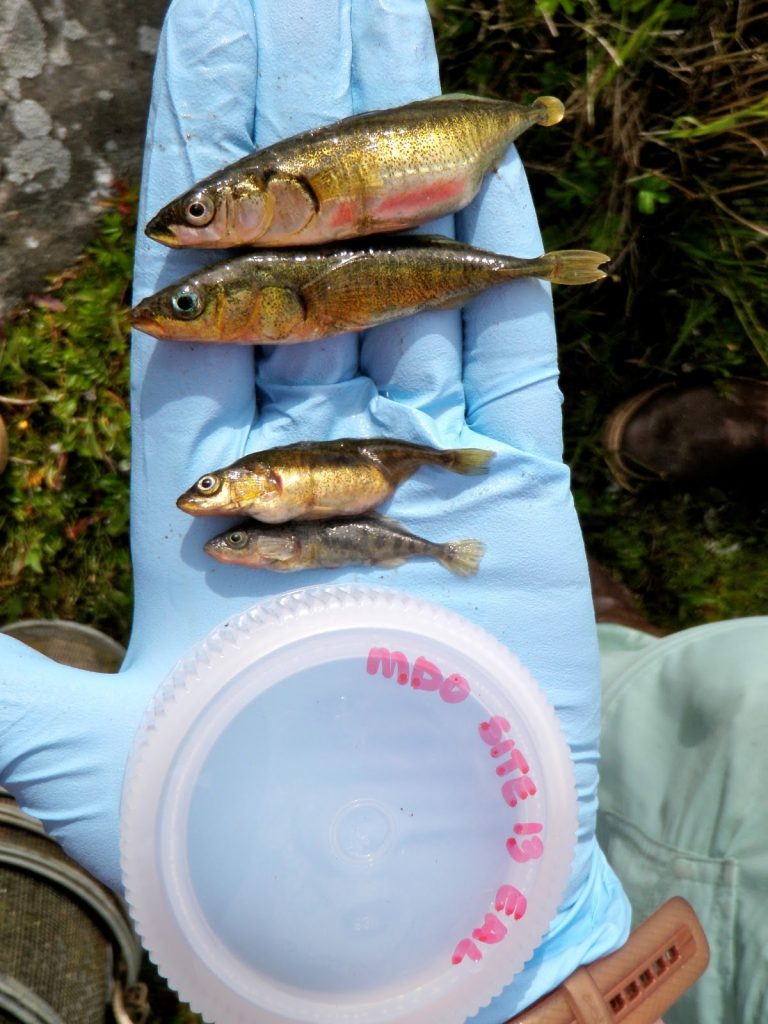New genetic data help explain the rapid adaptation of stickleback fish that invaded freshwater habitats in the 1960s.
In 1964, an earthquake shook the islands off the coast of Alaska, transforming the landscape as underwater terraces were thrust above the surface. From this cataclysmic event emerged a series of freshwater pools that became a natural laboratory in which to study evolution in action. A new report in GENETICS takes a closer look at how this sudden environmental shift influenced the adaptation of one particular inhabitant.
On the Alaskan islands, the newly-formed freshwater ponds were colonized by interlopers from the sea: marine stickleback fish. These ocean dwellers quickly adapted to the new environment, acquiring many traits not unlike those found in other, much older stickleback populations that are specialized for living in freshwater. Evolution at this dramatic scale is normally thought to take thousands of years rather than a half-dozen decades, which lead the authors to wonder how such rapid adaptation occurred. “It’s a great natural evolutionary experiment,” said Susan Bassham, one of the lead authors of the study.
Senior author William Cresko and his group have been studying sticklebacks (Gasterosteus aculeatus) for decades, and for good reason—the fish are an excellent model system for understanding adaptation and evolution.
“When our collaborator Frank von Hippel told us about his work surveying possible new stickleback habitats, including on these earthquake islands, we got excited. We immediately wanted to look at the phenotypic and genomic changes that might have happened after the island was uplifted and these new ponds were invaded by marine stickleback,” said Cresko. “This started a long and productive collaboration between our groups.”
Bassham explained that threespine stickleback have colonized a number of diverse environments over the millennia that the species has existed: as well as marine and freshwater stickleback varieties, there are sticklebacks that spend some time in both environments, much like salmon. Despite adapting to such varied habitats, all of these fish are still one species.

Marine (top) and freshwater (bottom) threespine stickleback fish. Photo by Emily Lescak.
To understand the genetics underlying the rapid adaptation of stickleback, the authors genotyped fish from three stickleback populations: those from the newly formed pools, those from other freshwater populations, and marine fish. They used restriction site-associated DNA sequencing, or RAD-seq, a technique that their lab has helped pioneer; this method allows for the rapid identification of genetic markers by sequencing regions of the genome adjacent to restriction sites. Cresko explained that RAD-seq’s focus on limited regions of the genome makes it more economical than other techniques, allowing for the acquisition of a complete genomic “snapshot” for thousands of individual fish. “This breadth of biological sampling was needed to answer some key population genomic questions about these fish,” said Cresko.
Using this approach and new computational tools developed in collaboration with second lead author Julian Catchen, the group identified several regions of the stickleback genome that vary significantly between the ancestral marine stickleback populations and those from the new freshwater pools.
Intriguingly, the changes that they found in the young freshwater populations on the Alaskan island were virtually identical to the changes seen in freshwater stickleback populations that have existed in other locations for thousands of years. They also found some of these same freshwater-adapted haplotypes scattered in the genomes of marine fish as far away as coastal Oregon—but at much lower frequencies.
These results suggest that the rapid adaptability of stickleback is largely attributable to standing genetic variation in the marine population. When environmental pressures change, the existing freshwater-adapted alleles face powerful selection and become prevalent. Although this idea was proposed a while ago, the current GENETICS study had the power to detect and accurately measure the frequency of these alleles in marine populations.
The similarities among different freshwater populations is also striking because those populations are otherwise genetically indistinguishable from marine stickleback. “When you look at the regions of the genome that are not divergent between ocean and freshwater and do a phylogeographic study, there’s no population structuring at all,” said Cresko. The genomes are so similar, he explains, that the only parts that differentiate them are the dramatic regions related to adaptation. “There’s very little neutral divergence; it’s nearly all due to natural selection.”
Ironically, this fascinating finding has posed something of a technical stumbling block for learning more. Delving deeper into the precise genetic differences between freshwater and marine sticklebacks would usually be done with a genome-wide association study, but such studies require distinguishable variation between populations. In other words: these fish are evolving so quickly that it’s impossible to control for population structure.
That doesn’t mean these questions can’t be answered, though. Bassham, Cresko, and their colleagues are currently studying other wild stickleback populations to identify genes that might underpin their ability to rapidly adapt to freshwater conditions, and they are creating new models to experimentally validate those findings in the laboratory.
CITATION:
, , ,
Genetics July 2018 209: 921-939; https://doi.org/10.1534/genetics.117.300610
http://www.genetics.org/content/209/3/921
[wysija_form id=”1″]













